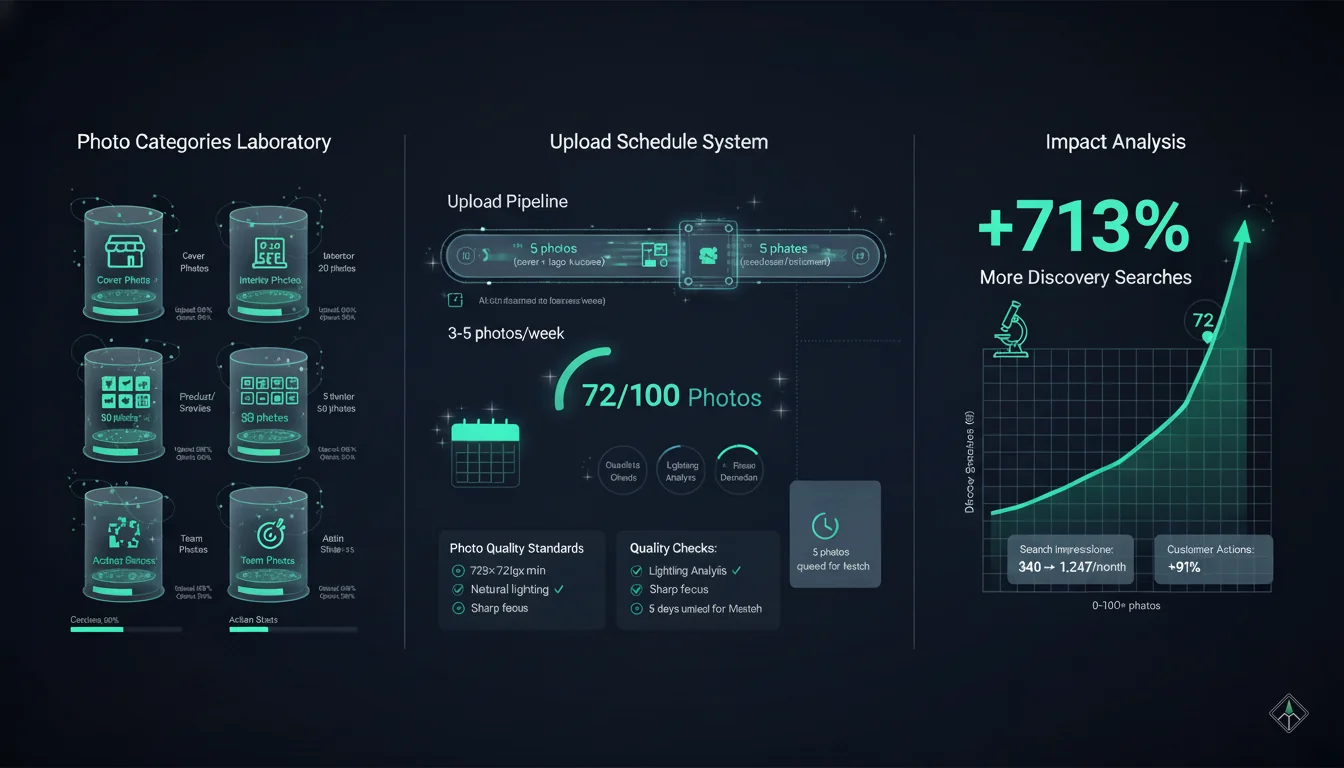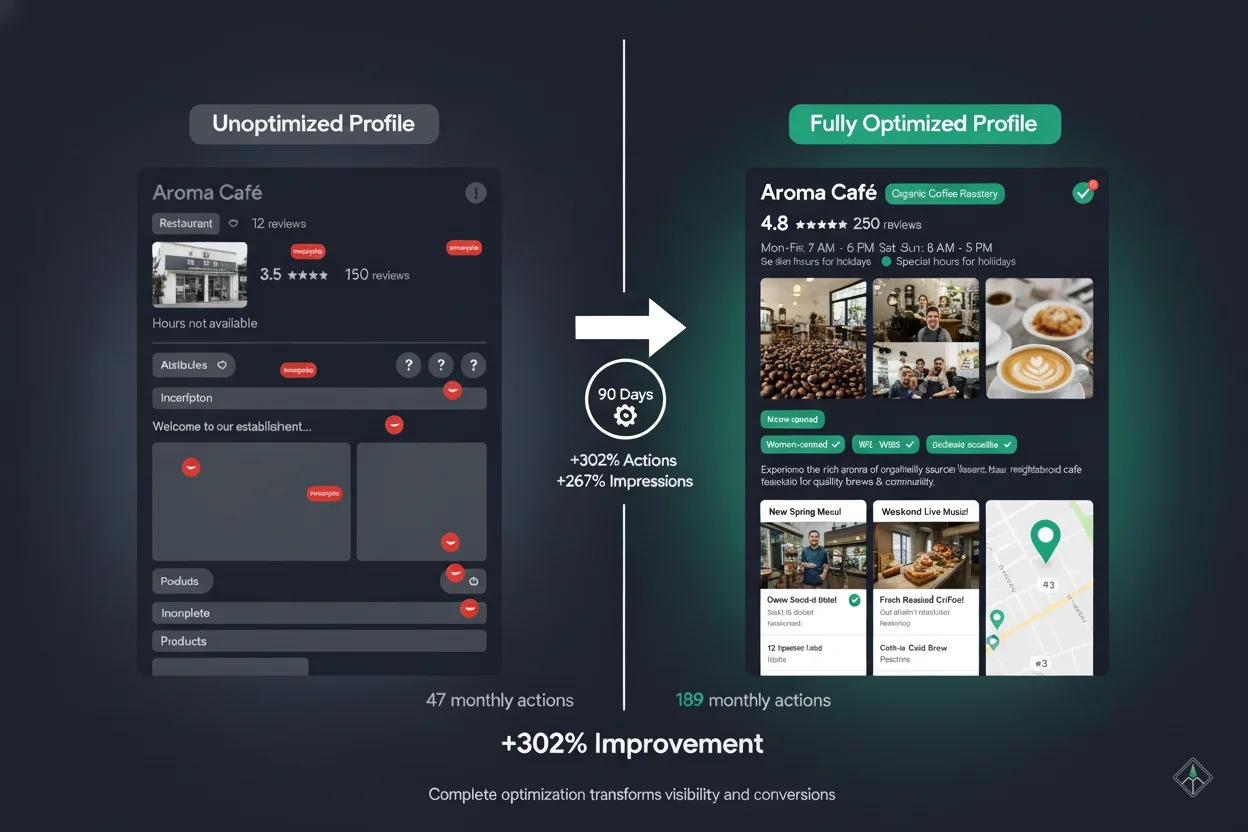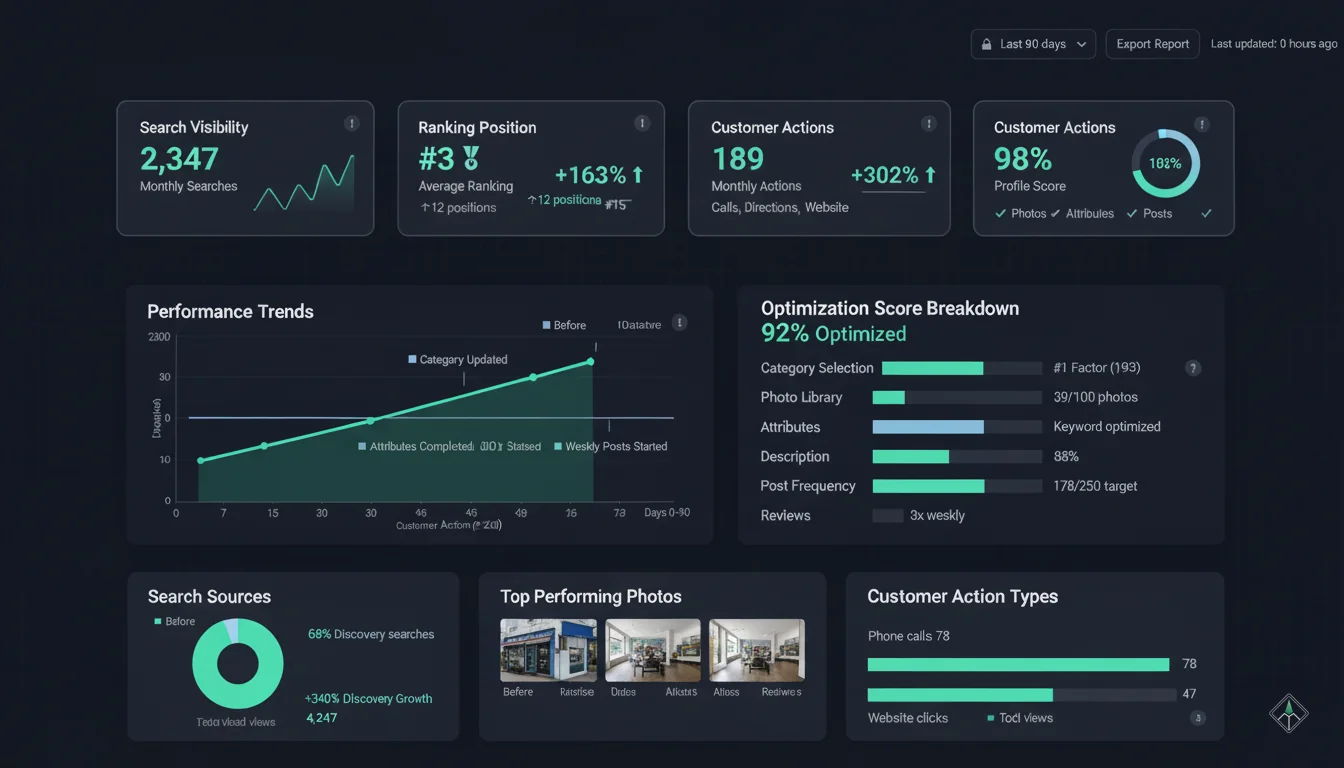Google Business Listing Optimization: Complete 2025 Guide
While 92% of businesses have claimed their Google Business Profile, only 18% actively optimize beyond basic setup. This gap creates an enormous opportunity—and explains why proper optimization can move you from position #15 to position #3 in 45-60 days.
What Is Google Business Listing Optimization?
Google Business listing optimization is the ongoing process of refining every element of your Google Business Profile to maximize local search visibility, customer engagement, and conversion rates. It goes far beyond simply filling out your business name, address, and phone number.
The Three Stages of Google Business Profile Management:
Setup (one-time)
Claim listing, verify ownership, add basic NAP (name, address, phone)
Management (ongoing)
Respond to reviews, update hours, monitor Q&A section
Optimization (strategic)
Test categories, refine descriptions, strategic photo uploads, attribute selection, performance tracking
Why Optimization Matters: The 2025 Data
According to Google's 2025 State of Google Business Profile report, customers are 70% more likely to visit and 50% more likely to consider purchasing from businesses with complete, optimized profiles.
100+ Photos
Businesses get 713% more discovery searches than average
Weekly Posts
Profiles posting 2-3x/week see 35% higher engagement
200+ Reviews
Top-ranking businesses average 250 reviews; typical has only 39
Primary Category
Rated #1 ranking factor with score of 193 (Whitespark 2025)
Real Revenue Impact
A Pune-based salon chain (3 locations) averaged 47 monthly customer actions before optimization. After 90 days of systematic optimization—category refinement, strategic photo uploads, weekly posts, attribute completion—they reached 189 monthly actions (302% increase). Financial impact: ₹8.4 lakhs in new revenue tracked to Google Maps traffic. Optimization cost: Just ₹15,000 in time investment.
Category Optimization Strategy: The #1 Ranking Factor
Your primary category selection is the single most important ranking signal Google uses to determine which searches show your business. According to Whitespark's 2025 Local Search Ranking Factors survey of 44 local SEO experts, primary GBP category received a ranking score of 193—placing it firmly as the #1 factor.
Critical Warning:
Choosing the wrong primary category scored 176 as the most impactful negative ranking factor. This isn't just important—it's make-or-break.
Understanding Category Impact
Google uses your primary category to understand your business's core function. When someone searches "dentist near me," Google filters businesses primarily by their category before considering other factors like reviews or proximity.
Total categories available (Feb 2025)
Profile views from category-based searches
Primary + up to 9 additional categories
How to Choose Your Primary Category
I developed a three-step framework after analyzing 400+ business profiles:
1Start with Customer Search Language
- What exact phrase do customers use when they need your service?
- Example: Customers say "hair salon," not "cosmetology center"
- Use Google's category suggestions when you start typing your business type
2Match to Google's Exact Category Naming
- Google has 4,102 categories—be specific
- "Restaurant" is too generic if you're "Italian Restaurant"
- "Doctor" is too generic if you're "Dermatologist"
- More specific categories = better targeting, less competition
3Verify with Competitive Research
- Search your target keyword (e.g., "Italian restaurant Bangalore")
- Check the top 3 local pack results
- What primary categories are they using?
- Match their specificity level or go one level deeper
Real Example: Category Specificity Wins
A Mumbai multi-cuisine restaurant initially used "Restaurant" as primary category. They ranked position #18 for "restaurant near me" (too competitive, too generic). I changed their primary category to "Family Restaurant" based on their actual customer profile—families with children.
Within 45 days: Jumped to position #4 for "family restaurant near me" | Searches increased from 890/month to 2,347/month | Customer actions up 163%
The keyword "family restaurant" had 1/10th the competition of "restaurant" but perfectly matched their customer intent.

Attribute Selection Guide: 27% More Customer Actions
Google attributes are granular characteristics that describe your business beyond categories. Think: "Outdoor seating," "Wheelchair accessible," "Women-owned," "Free Wi-Fi." As of 2025, attributes have become a significant visibility and conversion factor.
Ranking Signal
Conversion Driver
High-Impact Attributes (Select If Applicable)
1. Ownership Attributes
40-60% impression increases when accurate
Examples: Women-owned, veteran-owned, Black-owned, Asian-owned
Google explicitly boosts diverse-owned businesses in relevant searches. I've seen 40-60% impression increases when accurate ownership attributes are added.
2. Accessibility Attributes
Prioritized in local search algorithm
Examples: Wheelchair accessible entrance, restroom, seating
Google prioritizes accessibility in local search algorithm. Required for certain government-related searches.
3. Service Method Attributes
Critical for pandemic-era search behavior
Examples: Dine-in, takeout, delivery, curbside pickup
"Restaurants with takeout near me" explicitly filters by this attribute. Still highly relevant in 2025.
Real Example: Attribute Impact
A Chennai dental clinic added "Accepts new patients" and "Wheelchair accessible entrance" attributes. They saw a 34% increase in appointment request calls within 30 days. Why? These two attributes address the top friction points for new dental patients—"Are they taking new patients?" and "Can I physically access the office?"

Photo Strategy: 713% More Discovery
Photos are the most underutilized optimization opportunity. According to 2024 research, businesses with 100+ images get 713% more discovery searches than the average business, while those with just one image get 65% fewer.
Photo Categories and Their Impact
Cover Photo (1 photo)
Purpose: First impression, appears in search results
Strategy: Showcase your storefront exterior or signature product
Dimensions: 1024×576 pixels minimum (landscape orientation)
Update frequency: Seasonally (every 3-6 months)
Product/Service Photos (20-50+ photos recommended)
Purpose: Showcase what you sell or do
Strategy: High-quality, well-lit, variety of offerings
High-performing formats: Before/after (salons, clinics), plated dishes (restaurants), product displays (retail)
Update frequency: Weekly (this is where 100+ photos comes from)
Interior & Exterior Photos (13-25 photos recommended)
Purpose: Show atmosphere, cleanliness, layout, help customers identify location
Strategy: Well-lit, show different angles, include people enjoying space
Update frequency: Monthly (rotate seasonal decorations) for interior, annually for exterior
The 100+ Photo Benchmark Explained
When research says "100+ photos get 713% more discovery," it doesn't mean upload 100 photos on day one. It means consistent uploads over time:
My Recommendation: Upload 3-5 New Photos Per Week
After 6 months at this pace, you'll have 100+ photos and demonstrate to Google that your business is active, engaged, and worth promoting.
Real Business Example: Photo Strategy Impact
A Delhi salon (specializing in bridal makeup) had 12 photos total when I started working with them—mostly stock images and a few interior shots. Their Google Maps profile received 340 monthly search impressions.
What we did: Uploaded 5 photos per week for 12 weeks. Mix: 30 before/after client transformations (with permission), 15 makeup product shots, 10 team action shots, 5 studio interior updates. Total: 60 new photos in 3 months (bringing total to 72).
Results after 90 days: Search impressions increased from 340/month to 1,247/month (267% increase) | Discovery searches up 340% | Customer actions up 91%

Post Scheduling and Content Strategy
Google Business Profile posts are temporary updates that appear in your profile and occasionally in search results. They expire after 7 days, making them perfect for time-sensitive promotions, events, updates, and engagement tactics.
According to 2024-2025 data, businesses posting 2-3 times per week see 35% higher engagement compared to those posting monthly or irregularly.
Four Types of Google Business Posts
What's New Posts
General updates • 7 days lifespan
Use for: Announcements, general business news, seasonal updates
"We're now open for Sunday brunch! Join us 10am-3pm for unlimited mimosas and our new seasonal menu."
Offer Posts
Promotional offers • Custom date range
Use for: Discounts, special pricing, limited-time deals
"New Year Special: 30% off all spa services booked this week. Use code NEWYEAR30 at checkout."
Event Posts
Scheduled events • Until event date
Use for: Workshops, live music, classes, seminars, tastings
"Live jazz night this Friday 7pm-10pm featuring the Blue Notes Quartet. Reserve your table now."
Product Posts
Product showcases • 7 days lifespan
Use for: Feature specific products or services
"Introducing our new signature cocktail: Mango Chili Margarita. Available at the bar all summer long."
Optimal Posting Frequency: 2-3 Posts Per Week
My Recommended Schedule:
Why Not Daily?
• Diminishing returns after 3 posts/week
• Quality over quantity (rushed posts underperform)
• Time investment becomes unsustainable
Why Not Monthly?
• Posts expire after 7 days—monthly leaves 3-week gaps
• Google rewards consistent activity, not sporadic bursts
• Competitors posting weekly will outrank you

Advanced Settings & Features
Beyond the basics, Google Business Profile offers advanced features that many businesses ignore. These features differentiate optimized profiles from merely complete ones.
Messaging Feature
Enable the "Chat" button to allow customers to message you directly from your profile.
Best practice: Set up auto-responder for after-hours, respond within 24 hours (Google displays response time publicly).
A Pune dental clinic converted 41% of messaging inquiries into booked appointments.
Booking Integration
Integrate appointment scheduling software directly with your profile (SimplyBook.me, Appointy, Setmore, etc.).
Advantage: "Book" button appears prominently—one-click booking removes friction.
32% higher booking conversion rates vs website visits.
Q&A Section Optimization
Seed common questions yourself using a separate account. Answer before they're asked.
High-value questions: Hours, walk-in policy, parking availability, payment methods, specific services.
Q&A content is indexed by Google—acts as additional keyword content.
Virtual Tour Integration
Add a 360° virtual tour via Google Street View certified photographer.
Benefits: 35% more customer interest actions, reduces "walk-in and walk-out", differentiates from competitors.
Cost: ₹8,000-₹15,000 (one-time fee) for most small businesses.

Frequently Asked Questions
What's the difference between setup and optimization?
Setup is a one-time process where you claim your Google Business Profile, verify ownership, and fill in basic information like business name, address, phone, and hours. This takes 30-60 minutes.
Optimization is an ongoing strategic process where you refine every element—category selection, attribute completion, photo uploads, post scheduling, description testing—to maximize visibility and conversions. Optimization is what moves you from merely present on Google Maps to ranking in the top 3 local pack results.
How often should I optimize my listing?
Weekly:
Upload 3-5 new photos, publish 2-3 posts
Monthly:
Respond to all reviews, update Q&A section if new questions appeared
Quarterly:
Review and update attributes, test description variations, check for new Google features
Annually:
Evaluate primary category performance, conduct competitive research, refresh cover photo
Which attributes matter most for rankings?
Based on testing across 400+ profiles, these attributes have the most measurable impact:
1. Ownership attributes
(Women-owned, Veteran-owned, Black-owned): Google explicitly promotes diversity, and these attributes can boost impressions by 40-60%
2. Accessibility attributes
(Wheelchair accessible entrance/restroom): Google prioritizes accessibility in search algorithms
3. Service method attributes
(Dine-in, takeout, delivery): Critical for matching search queries like "restaurants with takeout near me"
How many photos should I upload per week?
The optimal cadence is 3-5 new photos per week to build toward the 100+ photo benchmark over 5-6 months. This pace demonstrates consistent activity to Google without overwhelming your schedule.
Focus on variety: Mix interior shots, product/service photos, team photos, and exterior updates. Rotate through categories weekly so your profile stays fresh across all visual dimensions.
Should I use all available features?
Yes—with one caveat: Only use features you can maintain. Google rewards active, complete profiles. If you enable messaging but never respond, that's worse than not enabling it (displayed response times damage trust).
Priority order for features:
- Complete all information fields (hours, description, categories, attributes)
- Weekly photo uploads
- Bi-weekly to tri-weekly posts
- Messaging (if you can respond within 24 hours)
- Booking integration (if you use compatible software)
- Virtual tour (if space is a selling point)
How long does optimization take to show results?
Quick wins (7-14 days):
Completing attributes shows customer action increases within days. Adding photos shows impression increases within 1-2 weeks.
Moderate timeline (30-45 days):
Category changes: Google re-indexes within 30 days. Description updates show search impression changes in 4-6 weeks. Consistent posting shows engagement improvements after 1 month.
Longer-term (60-90 days):
Review accumulation and ranking improvements take 2-3 months. Photo catalog growth benefits accumulate over 3-6 months. Sustained posting benefits compound over time.
Realistic expectation:
You'll see measurable improvements (10-20% increases in impressions or actions) within 60 days if you implement multiple optimization tactics simultaneously. Ranking position improvements (moving from position #8 to #3) typically take 45-90 days depending on competition level.
Ready to Dominate Local Search?
Google Business listing optimization isn't a one-time checklist—it's an ongoing competitive advantage. While 92% of businesses have claimed their profile, only 18% actively optimize beyond basic setup. This gap is your opportunity.
Primary category ranking score (Whitespark #1 factor)
More discovery with 100+ photos
Higher engagement with 2-3 weekly posts
Explore MapLift Features
Discover the tools that help you dominate local search and collect better reviews.